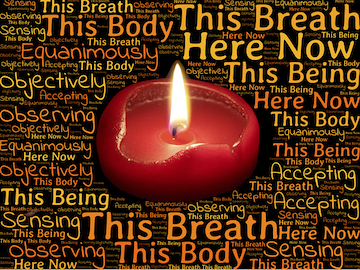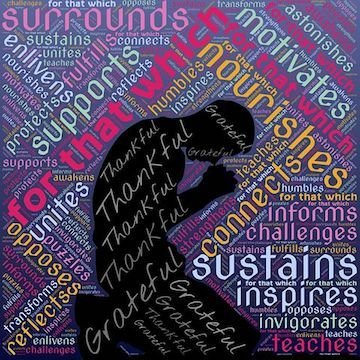The Buddhist 10 Fold Path
6. RIGHT EFFORT

In the Buddhist teachings, the Eight-fold Path is explained as a gradual training (anupubbasikkha), which unfolds itself in stages from the first step of starting and conceptually learning to the ultimate goal.
On this path, Right Effort is the first of the three steps in the concentration aggregate of the Eight-fold Path. Together with Right Mindfulness (sati) and Right Concentration (samadhi), it forms the basis and explains the practice and the objectives that are part of the Buddhist way of life for applying your mind internally and externally:

“One makes an effort to abandon wrong view and to enter upon right view: this is one’s right effort. Mindfully one abandons wrong view, mindfully one enters upon and abides in right view: this is one’s right mindfulness. Thus these three states run and circle around right view, that is, right view, right effort, and right mindfulness.” — AN III.72
An important aspect of Right Effort is right striving (sammappadhana), where it is vital to have a strong determination during the practice of Right Effort. Or even better, you could say that right effort equals right striving:

“And what, friends, is right effort? Here a monk awakens zeal for the non-arising of unarisen evil unwholesome states, and he makes effort, arouses energy, exerts his mind, and strives. He awakens zeal for the abandoning of arisen evil unwholesome states, and he makes effort, arouses energy, exerts his mind, and strives. He awakens zeal for the arising of unarisen wholesome states, and he makes effort, arouses energy, exerts his mind, and strives. He awakens zeal for the continuance, non-disappearance, strengthening, increase, and fulfillment by development of arisen wholesome states, and he makes effort, arouses energy, exerts his mind, and strives. This is called right effort.” — MN III.251-252
Two types of striving are mentioned that gives an idea of the Buddhist context in which it is taught:

“Monks, there are these two strivings that are hard to achieve in the world. What two? The striving of laypeople who dwell at home for the purpose of presenting [monastics with] robes, alms-food, lodgings, and medicines and provisions for the sick, and the striving of those who have gone forth from the household life into the homeless-life [of Buddhist wanderers] for giving up all acquisitions.” — AN I.49
The first type of striving asks for lay-people to support the monks who teach the Dhamma.The second type of striving is the Dhamma-follower’s way. The acquisitions (upadhi) that are to be given up are explained in greater detail in the Anguttara Nikaya commentary, where there are three types: the five aggregates [of becoming] (khandha), the defilements [greed, hate, and ignorance] (kilesa), and volitional activities (abhisankhara). Giving these up is being equated to nibbana itself. The striving for this is the energy arisen along with insight and the path.
The middle way of practice is recommended as something to strive for:

“And what is the middle way of practice? Here, a monk dwells contemplating the body in the body, ardent, clearly comprehending, mindful, having removed longing and dejection in regard to the world. He dwells contemplating feelings in feelings . . . mind in mind . . . phenomena in phenomena, ardent, clearly comprehending, mindful, having removed longing and dejection in regard to the world. This is called the middle way of practice.” — AN I.296
Right Effort is directly related to the four right types of striving, in that it explains the types of effort and it’s objective that are required as part of the practice:

“Monks, there are these four right strivings. What four? (1) Here, a bhikkhu generates desire for the non-arising of unarisen bad unwholesome states; he makes an effort, arouses energy, applies his mind, and strives. (2) He generates desire for the abandoning of arisen bad unwholesome states; he makes an effort, arouses energy, applies his mind, and strives. (3) He generates desire for the arising of unarisen wholesome states; he makes an effort, arouses energy, applies his mind, and strives. (4) He generates desire for the persistence of arisen wholesome states, for their non-decline, increase, expansion, and fulfillment by development; he makes an effort, arouses energy, applies his mind, and strives. These are the four right strivings.” — AN II.15
The objective of Right Effort is to create wholesome states [of the mind] (kusala dhamma) and to alleviate unwholesome states [of the mind] (akusala dhamma). The idea is that after some practice, one can identify and discriminate between wholesome- and unwholesome states of the mind:

“Venerable sir, for one who has no faith in regard to wholesome states, no sense of shame, no fear of wrongdoing, no energy, and no wisdom, whether day or night comes only decline is to be expected in regard to wholesome states, not growth.” — SN II.206
In the next post No. 7 of the path will be discussed: Right mindfulness.

The Nikayas are Buddhist books that form the earliest Buddhist canon of scriptures containing the teachings of the Buddha.
Today we’re going to be examining the Eight Fold Path, and even more so, the Ten Fold Path that is not as well known.
First of all, it really helps to have these books in digital form, so you can search for a particular word easily and be able to read how it is mentioned and in what context it is placed in the teachings of the Buddha.
The following English translations of the primary texts are available and used:
- The Connected Discourses of the Buddha: A Translation of the Samyutta Nikaya (SN)
- The Long Discourses of the Buddha: A Translation of the Digha Nikaya (DN)
- The Middle-Length Discourses of the Buddha: A Translation of the Majjhima Nikaya (MN)
- The Numerical Discourses of the Buddha: A Translation of the Anguttara Nikaya (AN
B. The Virtue and Moral Discipline aggregate of training
- Right livelihood (samma-ajiva)
C. The Concentration aggregate of training
- Right effort (samma-vayama)
- Right mindfulness (samma-sati)
- Right concentration (samma-samadhi)
The Ten-fold Path consists of two additional ‘folds’:
- Right knowledge / wisdom (samma-nana)
- Right liberation / release (samma-vimutti)
- AN = Anguttara Nikaya,
- DN = Digha Nikaya,
- MN = Majjhima Nikaya,
- SN= Samyutta Nikaya); followed by book number in roman capitalized numerals and verse number (for example, AN I.30 = Anguttara Nikaya book 1 verse 30).
Note: Quotations follow the PTS (Pali Text Society) naming and numbering format:
I will flag comment spam at 1% strength. If you keep on spamming my post I will flag you at 100%. I don't care if you have limited English abilities write a couple sentences about this article, no copy-paste please. I will flag: one sentence comments, links to your blog and begging for up-votes and follows. Also I will flag comments that have nothing to do with my blogs article. I will also check your comment section to see if you have been comment spamming on other blogs.


 A link to My Blog
A link to My Blog
Beautiful teaching for making the right things
Thank you @barbie.doll
as one seeking to grow and understand and who draws from many different spiritual lineages, i really appreciate these two things that point to trend, i think.
This points to a person gradually understanding and gaining experience from the practice itself. i am not a fan of dogma and i really appreciate this try it, you will see mentality. of course it can be helpful to have some guidelines, but i also agree if someone enters in with a true desire to learn and grow, they will know <3
I don't see this as dogma although the earliest text don't contain the eightfold path, the systemization of what the Buddha taught came later, probably around the first council. Don't take my word on this, I am taking this from a 20 year old memory.
What the Buddha taught is called the art of living. Depending on one's conditioning there are different teachings to help one let go of their conditioning and see reality as it is not as one thinks it should be. I see the eightfold path as a recipe, I practice making the food and when I become very good at it I can add different flavors and textures but the basic recipe is still the same. We all suffer from ignorance and need help letting that go, for me this is a good path. For others there are different paths to take, I think it's about karma. That's why you don't see Buddhist converting others to Buddhism. If the teachings fit like a good pair of shoes the rocks in the path won't hurt tender feet...hahaha
Maybe someday I can take my Dharma shoes off :p. If the teachings say you can't take your shoes off when you don't need them it's a cult!
hahah love it!
didn't mean to make it sound like i was calling this dogma. in fact i was pointing at the fact that to me it very clearly isn't!
i love this and i love the anecdote about taking the shoes off :) i'm also attracted to this path <3
Yeah anything including medicine that tells me I must take their ideology or views for the rest of my life is going to see me walking away fast! Find a good teacher because when you get into the wilderness of your mind you will need an experienced guide. I am speaking from experience ;-)
I've really enjoyed following this series. It's odd how different cultures in the USA are from eastern countries. I remember how natural it felt when I saw monks making the rounds for alms in Thailand. We sure don't have such a culturally accepted way for lay ppl to support monks in the USA! I appreciate the inspiration and knowledge, thanks.
I think all the religions taught here in the United States except Native American and the Mormon religion are from the east. I know many Buddhist retreats and lay centers that have tried to establish alms rounds, it's been difficult. I think it is because the state took over welfare and know JP Morgan hands out the food, I mean money...
Back in the day, even during my time as a child the needy were taken care of by the community they lived in, times have changed and Buddhism doesn't fit into a state run model unless it is the state religion. Korea, China, Japan had Buddhism for it's state religion, much like the West had Christianity as its state religion and the Middle East has Islam for it's state religion. Thank you @mountainjewel.
Hey very informative article. I was aware of the eightfold path, but never heard the extra two.
I think this is just the article that I needed to read this morning. I have been in an unwholesome state for a few days now. I have gotten very adept at being aware of an unwholesome state. I just keep it in my awareness and strive for resolve while trying to minimize any turbulence that is consequence of the state.
Thanks for the reminder and the lesson today @reddust
My favorite subject is the nana-vipassanas. The last two steps are fascinating. I learned sitting in meditation for 14 hours a day, every hour to three hours I would take breaks for walking, go to the bathroom, eat lunch and breakfast. I found nothing last long within the mind. Everything changes, knowing that it is easier to change my habits and work on developing healthy habits for a healthy life.
A change of view by giving up greed hate and ignorance. Yes it does make sense to me. Perhaps if more folks embraced Buddha the world would be a better and more peaceful place. Thanks @reddust.
We change our views all the time, the trick is to find right view. That's where a teacher comes in handy!
Very detailed, I’m grateful to have bloggers like you on Steemit. Followed! I’m writing on a similar topic- feel free to check out my blog for various meditations and spiritual exercises. My followed list is also full of some great resources! Best.
There are a lot of articles about meditation and mindfulness I decided to write about the basics. It is good to go back and review my first lessons. I just checked out your blog and it is very nice. Thank you @jspots.
If you want to change your life just start with small steps, by being a bit happier about your life and appreciating what you currently have. That state of mind will shift from where you are to a different place, but you have to be consistent; otherwise, you might give up.
may god bless you and your family.
I think, that is from my own experience no one can change your mind except you. when you change your mind you change the world. Thank you @robert31
why do you put a photo of the top leaves.
whether it is a symbol of Buddhism
The leaves of the Bodhi tree represent Gautama Buddha's enlightenment and the Dhamma teachings. The Dhamma teachings are taught by every Buddha, they are not his or hers. The teachings are forgotten and are remembered and taught be enlightened humans.
oh yes yes.
I see.
You are right @reddust.We can change the world by start doing right things.quit the wrong first and then advise others to do right things :)
It takes strong determination, right effort to let go of old negative habits and establish positive habits. Thank you @munazza
Hi @reddust been a while
Actually this is my first time of reading through a buddhist teaching.
That was really an exhaustive expository. This has aroused my curiosity to know more.
I will research deeper, will need your help on that thanks
Have a lovely day ahead
The teachings have had over 2500 years to grow....hahaha
I hope you find a good recipe for the art of living in my post that furthers your research. If you like philosophy you will love the teachings. The simplest ones, which are my favorite come from the Dhammapada. You can find them online.